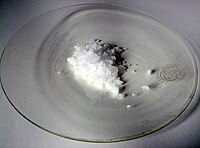Ammonium peroxydisulfate
 |
|
 |
|
 |
|
| Names | |
|---|---|
| Other names
Ammonium peroxydisulfate
|
|
| Identifiers | |
|
7727-54-0 |
|
| 3D model (Jmol) |
Interactive image Interactive image |
| ChemSpider |
56400 |
| ECHA InfoCard | 100.028.897 |
| EC Number | 231-786-5 |
| E number | E923 (glazing agents, ...) |
| PubChem | 62648 |
| RTECS number | SE0350000 |
| UNII |
22QF6L357F |
| UN number | 1444 |
|
|
|
|
| Properties | |
| (NH4)2S2O8 | |
| Molar mass | 228.18 g/mol |
| Appearance | white to yellowish crystals |
| Density | 1.98 g/cm3 |
| Melting point | 120 °C (248 °F; 393 K) decomposes |
| 80 g/100 mL (25 °C) | |
| Solubility | Moderately soluble in MeOH |
| Hazards | |
| Safety data sheet | External MSDS |
|
EU classification (DSD)
|
Oxidant (O) Harmful (Xn) Irritant (Xi) |
| R-phrases | R8, R22, R36/37/38, R42/43 |
| S-phrases | (S2), S22, S24, S26, S37 |
| NFPA 704 | |
| Lethal dose or concentration (LD, LC): | |
|
LD50 (median dose)
|
689 mg/kg, oral (rat) |
| Related compounds | |
|
Other anions
|
Ammonium thiosulfate Ammonium sulfite Ammonium sulfate |
|
Other cations
|
Sodium persulfate Potassium persulfate |
|
Except where otherwise noted, data are given for materials in their standard state (at 25 °C [77 °F], 100 kPa).
|
|
|
|
|
| Infobox references | |
Ammonium persulfate (APS) is the inorganic compound with the formula (NH4)2S2O8. It is a colourless (white) salt that is highly soluble in water, much more so than the related potassium salt. It is a strong oxidizing agent that is used in polymer chemistry, as an , and as a cleaning and bleaching agent.
The dissolution of the salt in water is an endothermic process.
Ammonium persulfate is prepared by electrolysis of a cold concentrated solution of either ammonium sulfate or ammonium bisulfate in sulfuric acid at a high current density. The method was first described by H. Marshall.
As an oxidizing agent and a source of radicals, APS finds many commercial applications.
Salts of sulfate are mainly used as radical initiators in the polymerization of certain alkenes. Commercially important polymers prepared using persulfates include styrene-butadiene rubber and polytetrafluoroethylene. In solution, the dianion dissociates to give radicals:
The sulfate radical adds to the alkene to give a sulfate ester radical. It is also used along with tetramethylethylenediamine to catalyze the polymerization of acrylamide in making a polyacrylamide gel, hence being important for SDS-PAGE and western blot.
...
Wikipedia

